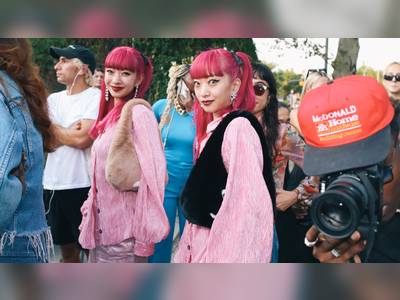Who needs to spend money on yet another boring T-shirt? When times get tough, women look for special self-pampering items or trendy, low-priced looks that do not require foregoing the latest rage. The strategies devised by shoppers to deal with the uncertain economy are a further twist in a complex and fickle industry that pressures women to refresh their wardrobe every season.
Yet clothing retailers are feeling the pinch as shoppers scale back on buying, amid escalating gasoline prices, a housing slump, tighter credit and widespread consumer skittishness. The trendiest fashions, after all, are nice to have, but hardly essential.
Sales of women's apparel are estimated to have dropped 3 percent in February and March from year-ago levels, according to market research firm NPD Group. The worst-hit categories? Coats, sleepwear and accessories.
"In this kind of economy, obviously there's the temptation to shop in your own closet," said Wendy Liebmann of marketing consultants WSL Strategic Retail. "The temptation not to buy is clearly huge at this point."
Still, the truly dedicated shoppers are managing to find fashion fulfillment at the high end, and at the low.
Retailers like J Crew (JCG.N: Quote, Profile, Research) or Coach Inc (COH.N: Quote, Profile, Research) are banking that their best strategy lies in stocking one-of-a-kind items difficult to find elsewhere. Those items carry higher price tags, but shoppers may find that their quality and unique design justify the expense.
Every woman has a button-down shirt in her closet. But the sophisticated silver lame one at J Crew? Hard to resist."The 'wow' factor to really surprise and delight consumers becomes much more of an imperative during difficult economic times when women are making much sharper choices in how they spend," Coach Chief Executive Lew Frankfort told Reuters.
Moreover, purchasing such an item is partly a need to pamper oneself in difficult times, said Liebmann: "Because things are so damn gloomy, what's the little treat?"
CHEAP-CHIC, HIGH DEMAND
On the other end of the spectrum are women whose focus remains on the budget above all else.
"In times like this, some consumers flock to more value price points," VF Corp Chief Executive Eric Wiseman told analysts recently, citing down-shifts amid every segment.
The apparel maker, whose brands include Lee, Wrangler, Vans and North Face, saw weakness in its jeans division in the most recent quarter as customers gravitated to lower-priced denim.
Value-seekers who do not want to sacrifice style in the equation, are shopping at fast-fashion chains like Zara (ITX.MC: Quote, Profile, Research), H&M HMB.ST, Forever 21, and even Target Corp (TGT.N: Quote, Profile, Research), which just launched a new private-label line called Go International. All offer runway-inspired looks at cheaper prices.
"These cheap-chic brands are going to pick up and have more traction," said Pam Danziger, a consumer insights expert at Unity Marketing.
H&M, for example, sells billowing skirts and dresses in orange, fuchsia and teal pop-art fabrics -- all below $100.Moreover, a "paradigm shift" in how Americans perceive conspicuous luxury means consumers will be less likely to spend hundreds of dollars on trendy items that will go out of fashion after a season, Danziger said.
Still, others may view the practice of seasonally casting off the latest cheap styles as wasteful in this more ecologically conscious, and value-driven world, said Liebmann.
"The key is in these times: How do you present innovation, value, relevance, even good citizenship?" Liebmann said. "All these things are going on which are reasons to get people to get out of their houses, to get into stores and buy more things to put on their backs."
Furthermore, in a cruel twist, fickle fashion whimsy will demand that wallets be opened wider this fall. It's the time of year that "in" designer styles combat the chill by celebrating rich, luxurious fabrics and tailoring that costs more, not less.
Women may have gotten used to recycling their warm-weather looks from past seasons -- spring and summer fashion has not changed that much, after all -- but come fall, as hemlines drop and pant-legs get wider, a shopping trip may be required.
"The scruffy poor look is phasing out just as everyone is getting poorer," said David Wolfe, creative director of fashion consultant The Doneger Group. "Women are going to wish they had more discretionary money to spend. Everything is being upgraded because the look is dressier."
(Additional reporting by Martinne Geller; Editing by Gunna Dickson)













